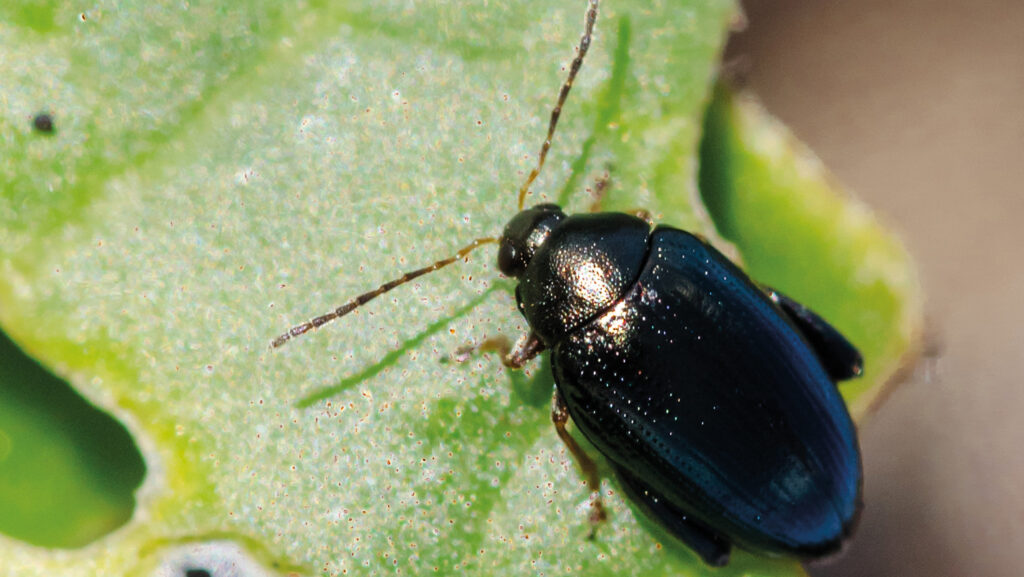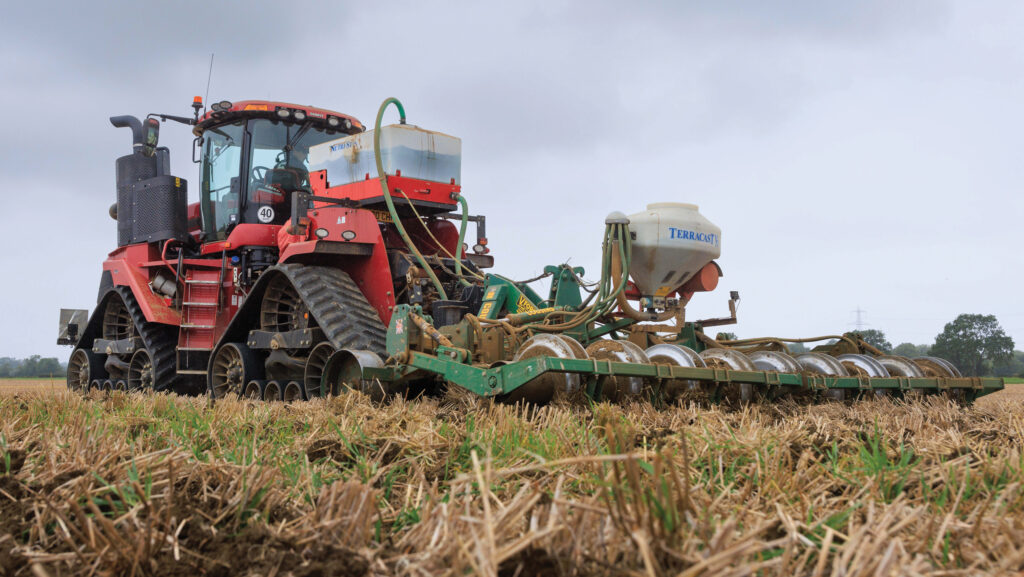Which IPM options are best to manage cabbage stem flea beetle?
 © Blackthorn Arable
© Blackthorn Arable With no single chemical or cultural approach that reliably manages cabbage stem flea beetle numbers, control requires a combination of techniques to suppress populations of the pest.
But with dozens of possible integrated pest management (IPM) strategies, which ones should farmers consider?
AHDB-funded research has taken a closer look and used a traffic light system to indicate which are most likely to give control.
See also: Trial reveals cost of unnecessary soil cultivations
Green: Best control
1. Soil moisture
Sufficient soil moisture during crop emergence is critical, says AHDB lead crop protection scientist Dr Sacha White. That’s because a lack of soil moisture results in delayed, uneven and non-vigourous emergence.
Consequently, cabbage stem flea beetle will pick seedlings off as they emerge over a few days or weeks. Even if there isn’t a big infestation, if farmers have poor emergence, then the flea beetle impact is greater.
Therefore, adjust sowing dates to help optimise moisture levels – wait until the seed-bed has sufficient moisture and/or rain is imminent.
Top tips:
Avoid drilling late August to mid-September (see “sowing date”).
2. Sow date
Early sowing (before late-August) increases the likelihood that the crop will emerge and establish sufficiently before flea beetle migration occurs, providing there is soil moisture.
This reduces the risk of the crop being lost to foliar feeding.
Late sowing (second half of September) may result in the crop emerging after the migration peak, reducing the threat from adult beetle feeding.
Such crops are also associated with reduced larval pressures, because egg laying and development is slowed by cooler conditions.
Trial results suggest a three-week delay in sowing may result in a 20-fold reduction in larval load.
Crops drilled between late August and mid-September tend to be at greatest risk from adult flea beetles. This is because peak adult beetle migration coincides with the most susceptible crop growth stages.
3. Trap crops
Oilseed rape volunteers can act as a trap crop and divert flea beetle away from nearby rapeseed crops. When the trap crops are destroyed, cabbage stem flea beetle eggs and larvae die.
Additionally, flea beetle lose wing muscles as their eggs develop, which means many will not be able to move from the trap crop to another OSR crop after the trap crop has been destroyed.
In trials, the approach reduced adult infestation (by up to 88%) and damage (by up to 76%) in the oilseed rape crop.
It also resulted in higher plant populations (by up to 56%) and reduced larval populations (by up to 69%). However, Sacha adds that benefits were variable and not always observed.
He says it’s likely that relatively large areas of adjacent trap crops (at least 2ha) are more likely to deliver benefits, especially if left in place until after the bulk of the flea beetle migration has occurred (in late September).
It is also believed that volunteers at an early growth stage at the end of August are most attractive to the adult beetle. Sown trap crops (such as turnip rape) and some cover crops may also be effective.
Top tips:
Use cultivations to encourage a fresh flush of volunteers or broadcast home-saved seed to produce a cheap, sacrificial trap crop. Avoid the temptation to remove OSR volunteers before late September.

© Tim Scrivener
4. Companion crops
Five trials carried out by AHDB revealed companion crops consistently reduce cabbage stem flea beetle pressure.
Every trial showed benefits, with up to 52% less crop damage, 47% fewer adults and up to 48% reduction in larval numbers observed.
Sacha says companion crops on their own they may not be the solution, but there is a consistent benefit.
In the trials, buckwheat or buckwheat plus berseem clover gave the best control. There was no impact on yield and minimal impact on crop development.
However, Sacha says that they need to be frost sensitive or easy to remove.
Top tips:
Sow companion crops one to two weeks before drilling oilseed rape.
Amber: Moderate control
1. Organic amendments
Trials have shown some benefits of organic amendments like digestate in reducing adult cabbage stem flea beetle numbers and improved establishment. Improved crop establishment is key to improve the chances that the crop is not wiped out by flea beetle.
Sacha says that more work is needed to see which amendments work best and how to apply them to maximise the benefits.
2. Managed defoliation
Flea beetle larvae are far more likely to be present in leaf petioles than in the stem.
Therefore, managed defoliation reduced larval numbers significantly in plot trials (by 23–55%), with late defoliation, before stem extension, being most effective.
However, while field scale trials using sheep or topping saw good reductions in larval loads, there was a reduction in final yields in most of the trials.
Sacha says this could be down to the defoliation being too severe or occurring too late.
“There is something in this, but crops need to recover and weather is key.” He points out that both trials experienced, cool, dry springs, which may have hindered crop recovery, so more work is needed.
Top tips:
Don’t defoliate after the New Year. Only leaves need to be removed, so don’t defoliate too intensively.
This approach is best suited to early drilled crops, as they are better able to withstand defoliation, and tend to have more larvae.
Stacking strategies
Any measure deployed to manage cabbage stem flea beetle is not guaranteed to work, so farmers need to manage their expectations.
For example, with sowing date, changes in weather could see the timing of adult flea beetle migration shift so that a mid-August sown OSR could be hit.
Or poor soil moisture could see emergence delayed.
AHDB’s Sacha White, therefore, advises a range of sowing dates to spread the risk. Also, stacking IPM strategies will also help to minimise risk.
Red: Little/no control
AHDB says there is currently little evidence the following strategies reliably offer control of cabbage stem flea beetle and more research is required:
- Novel insecticides/biopesticides
- Varieties
- Straw/stubble management (for example longer stubble length)
- Establishment technique
- Seed rate
- Enhanced crop resilience (through nutrition and plant growth regulation).

